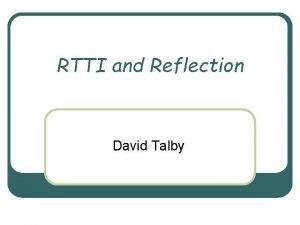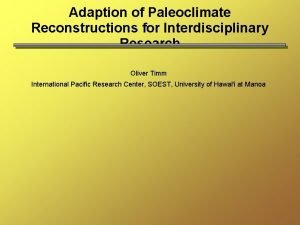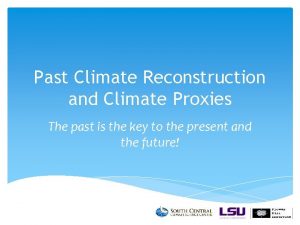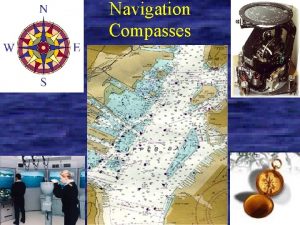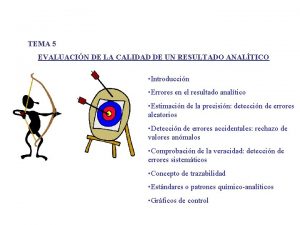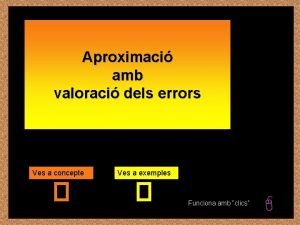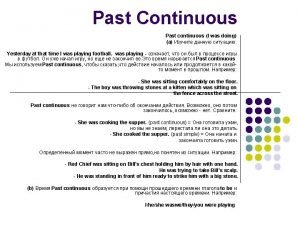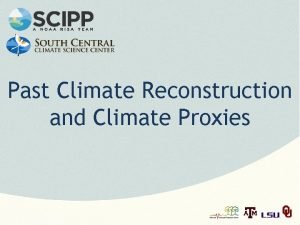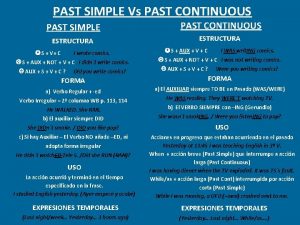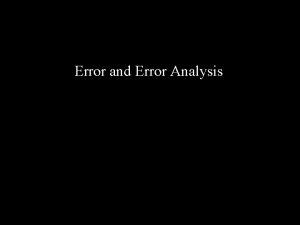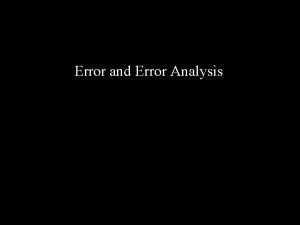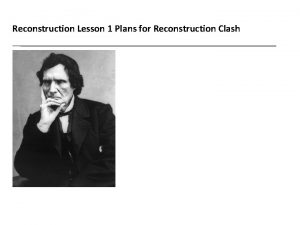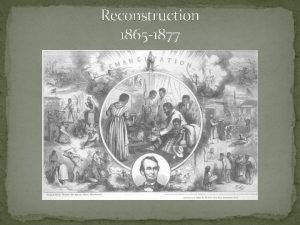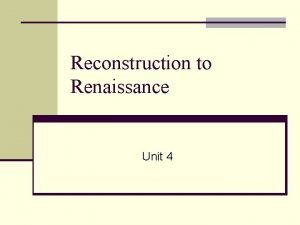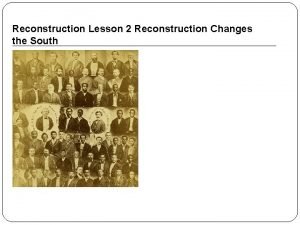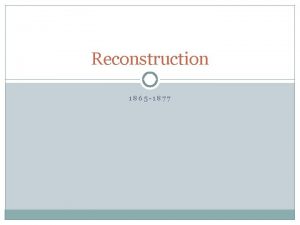Past Climate Reconstruction and Climate Proxies 2 Error
























- Slides: 24

Past Climate Reconstruction and Climate Proxies

2 Error bars for proxy data Paleoclimate Records Instrumental Records

The Instrumental Record The earliest records of temperature measured by thermometers are from western Europe in the late 17 th century and by the early 20 th century records were being collected in almost all regions. Records from polar regions began in the 1940 s. The National Climatic Data Center maintains a collection of temperature records from over 7, 000 stations worldwide, about 1, 000 go back to the 19 th century. Temperature observations the first 2 weeks of July 1776 in Thomas Jefferson’s Weather Memorandum Book

The Satellite-Derived Temperature Record Satellite measurements have been used to construct globally complete land oceanic temperatures since 1979. Provides a spatially uniform perspective whereas weather observations are biased towards where people are located. Allows for measurements over hard-to-sample areas like the oceans and ice sheets. Source: NOAA

Historical Records Historical documents contain past weather and climate information. Ship logs are particularly useful for accounts of sea ice, storms, and hurricanes. Farmers’ logs can include useful information such as planting or harvest dates and overall crop health. Personal diaries are another resource.

Paleoclimatology is the study of past climate that does not use instrumental observations but proxies from the environment. Proxies of climate variability are recorded in the rings of trees, coral colonies, ice sheets and glaciers, cave deposits, layers of sediments (pollen, microfossils, and organics) and more. These natural recorders of climate contain a chronology or way to tell time and they record changes in environment, driven by climate.

Annual banding Ice cores Varve sediments Tree rings Corals Count years Absolute age if date of collection is known GISP 2 National Ice Core Laboratory USGS Varves of Lehmilampi lake (Eastern Finland), light layer = spring flood mineral layer, dark layer=organic summer -winter 7 layer

Tree rings 8

9

Tree Ring Record Cross dating of tree rings can provide exact date matches between trees with different ages or from different locations. Major events such as fire, flood, avalanche, drought, and insect infestation can all be evident. The regular year to year variations in rings provide indications of past temperature, precipitation and streamflow. Using petrified or fossilized wood, tree ring records go back more than 10, 000 years in some locations. Source: NOAA

Dendrochronology Master chronology Many trees from a region are cross-dated Locally absent years False rings Quality Checked COFECHA 12

Tree Ring Record Example A several decade long North American drought in the late 16 th century is apparent from tree ring records. Source: NOAA

Corals as climate archives 14

Corals A coral is a colony composed of hundreds of thousands of tiny animals called coral polyps. Coral polyp deposits calcium carbonate, which forms the coral skeleton, and many corals form the coral reef. Within the coral skeleton are density bands, similar to tree rings and chemistry with the Skeletal depends on temperature and other environmental conditions. USGS De. Long A long core of a coral skeleton can cover hundreds of years and exact dates can be determined based on counting the growth bands or U-Th dating. Coral records help us understand the tropical climate system, which is a strong driver of global climate.

Coral SST reconstruction 16

Ice Core Records The Greenland ice sheet is nearly two miles thick and provides climate history going back 200, 000 years. Parts of the Antarctic ice sheet are even thicker, going back over 400, 000 years. Layers of dust present in ice cores from past windy seasons or could represent past volcanic eruptions. Tiny fossil air bubbles are even trapped in the ice, time capsules of past air. The ice can also be tested for its acidity level.

High Latitude Ice Records Most ice cores have been retrieved from high latitude sites in Greenland (GISP, GISP 2, GRIP) and Antarctica (Taylor Dome, Siple Dome, Vostok) 18

Ice Core Records Temperature change for the past 150, 000 years from an Antarctic ice core based on a hydrogen isotope proxy.

Vostok Antarctica Ice Core Record Petit et al. , 1999 20

Ocean Drilling 21

Marine Sediments 22

Sediments 23

Sediment Record Sediment cores from closed basin lakes in the Yucatan Peninsula indicate evidence of an intense period of drought that coincides with the collapse of the Classic Mayan Civilization. An archaeological mystery, southern Mayan cities were abandoned between 800 and 900 AD.

Other Proxy Records The geologic, fossil and sediment record also provide indications of Earth’s past climate. Pollen grains are especially well preserved in sediment layers, like at the bottom of a lake or ocean.
 Java reflection api
Java reflection api Palmyra soest
Palmyra soest Climate reconstruction
Climate reconstruction While when past simple past continuous
While when past simple past continuous Simple past past perfect past continuous
Simple past past perfect past continuous Type of errors in statistics
Type of errors in statistics Systematic error
Systematic error Difference between round-off error and truncation error
Difference between round-off error and truncation error Crc example
Crc example How to do percent error
How to do percent error Exercise past simple past continuous and past perfect
Exercise past simple past continuous and past perfect Past porfect
Past porfect Type 2 vs type 1 error
Type 2 vs type 1 error C d m v t
C d m v t What is a null hypothesis
What is a null hypothesis Alternating series error bound
Alternating series error bound Error sistematico y error aleatorio
Error sistematico y error aleatorio Error
Error Sesgo de berkson
Sesgo de berkson Error absolut i error relatiu
Error absolut i error relatiu Invertery
Invertery During error reporting, icmp always reports error messages
During error reporting, icmp always reports error messages Climate change 2014 mitigation of climate change
Climate change 2014 mitigation of climate change Perfect past progressive
Perfect past progressive Participle 2 таблица
Participle 2 таблица
